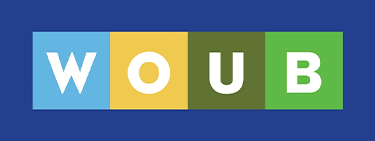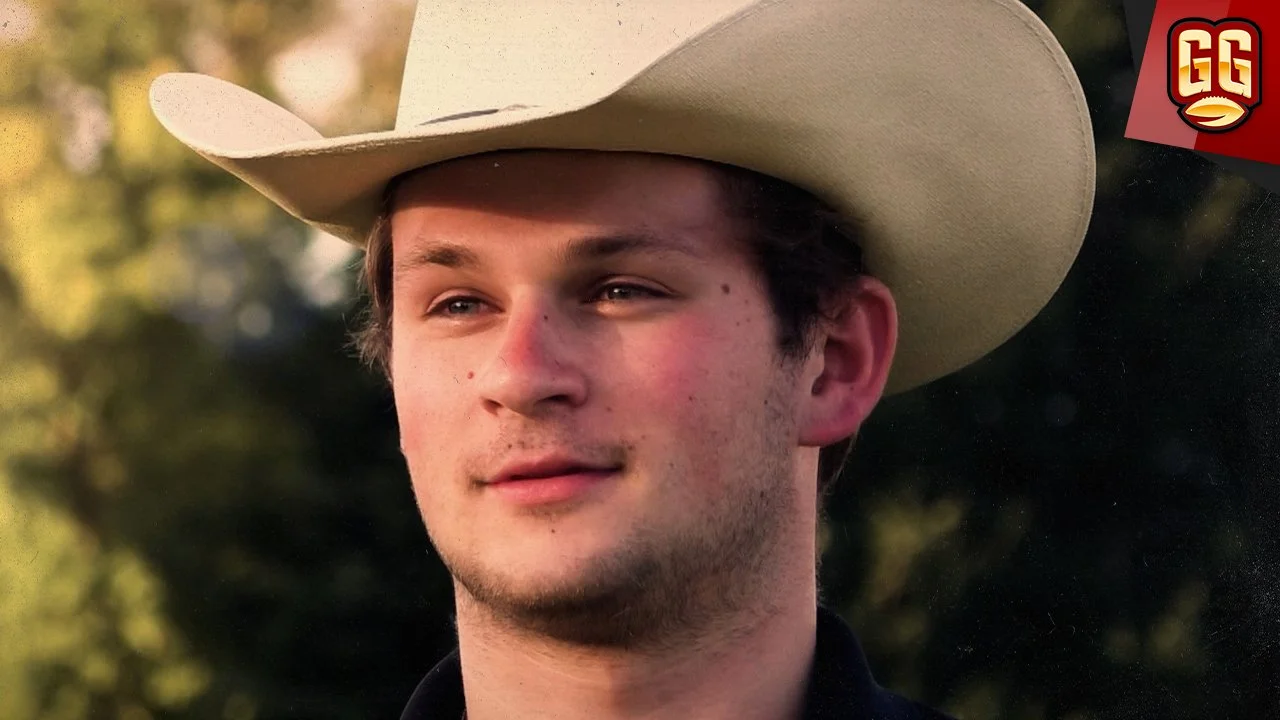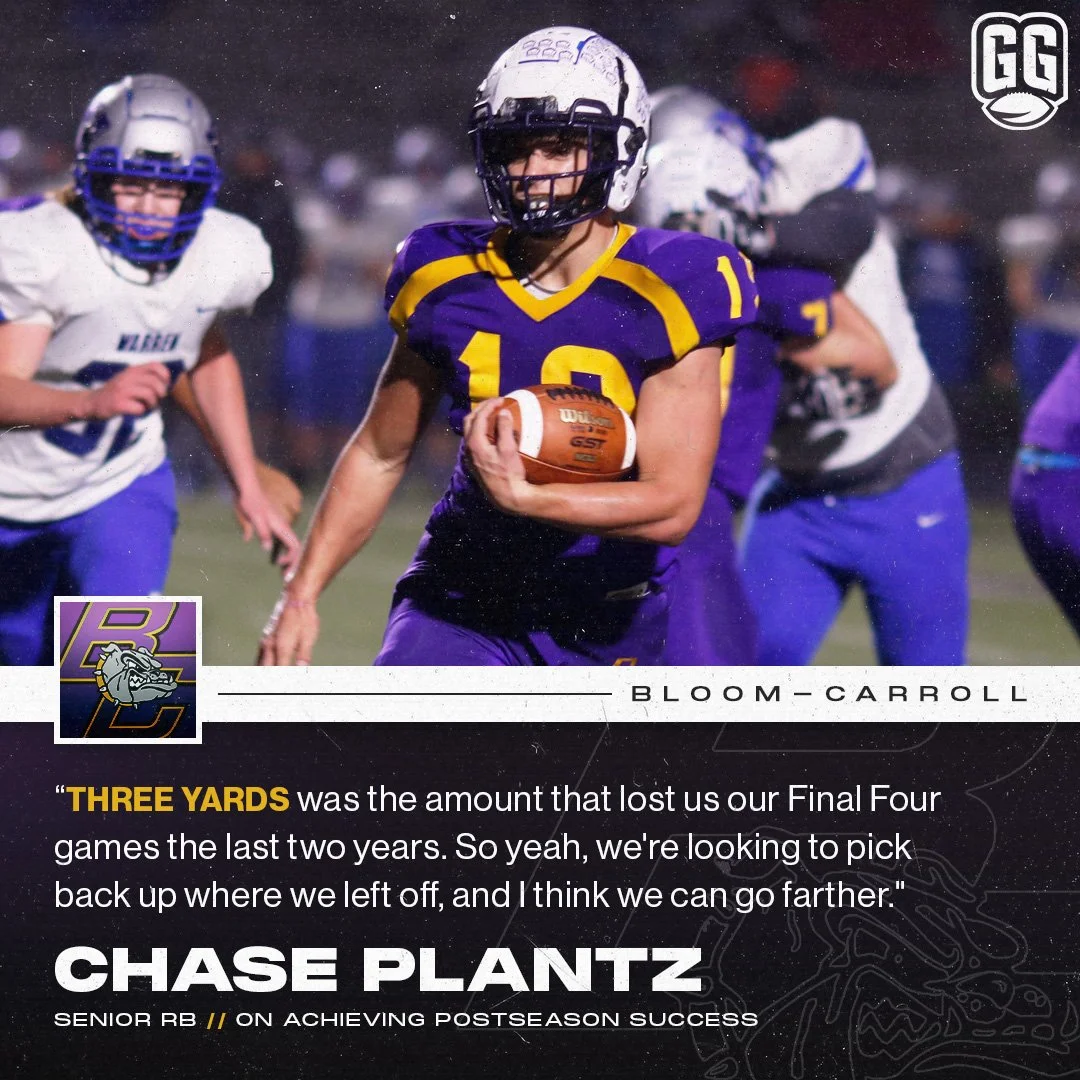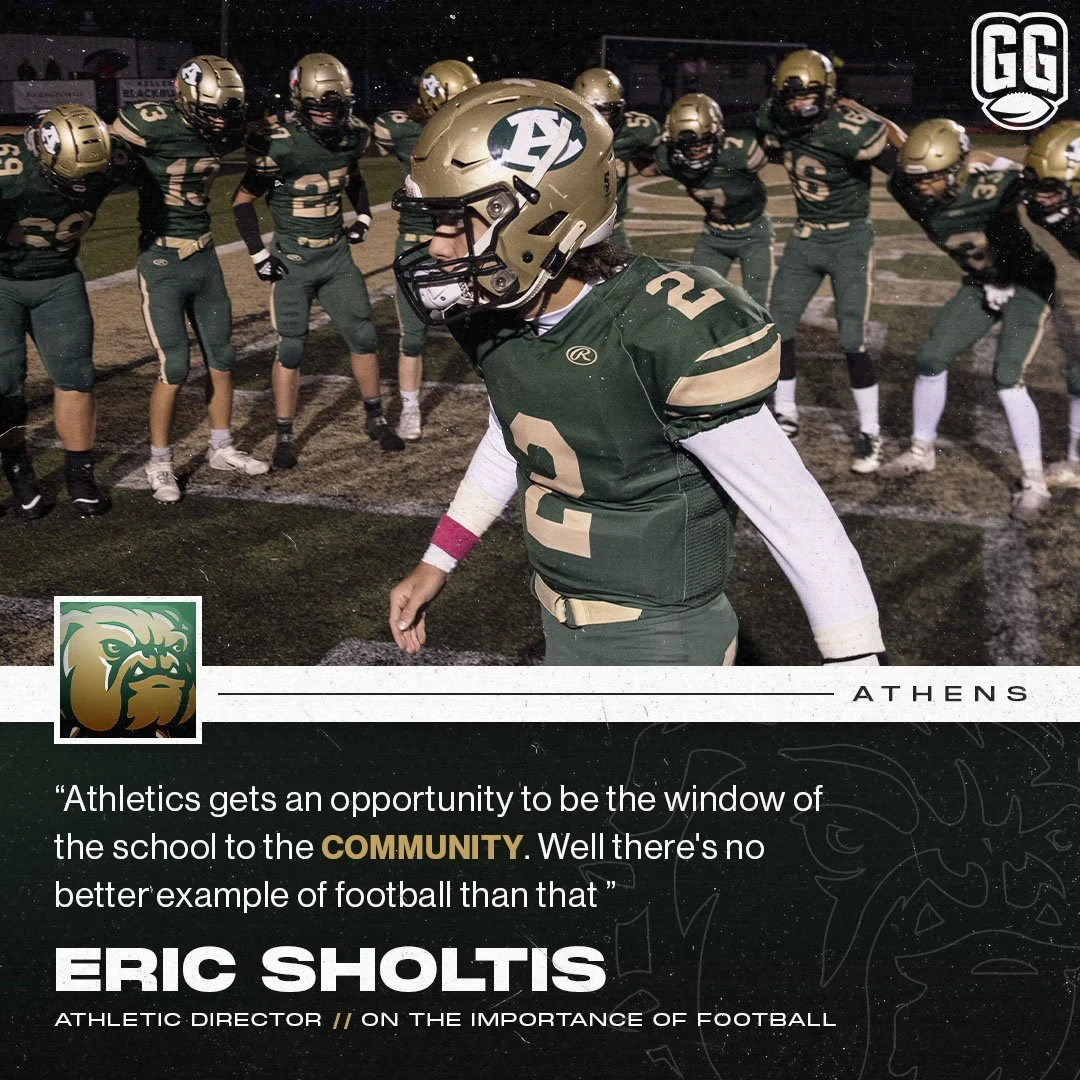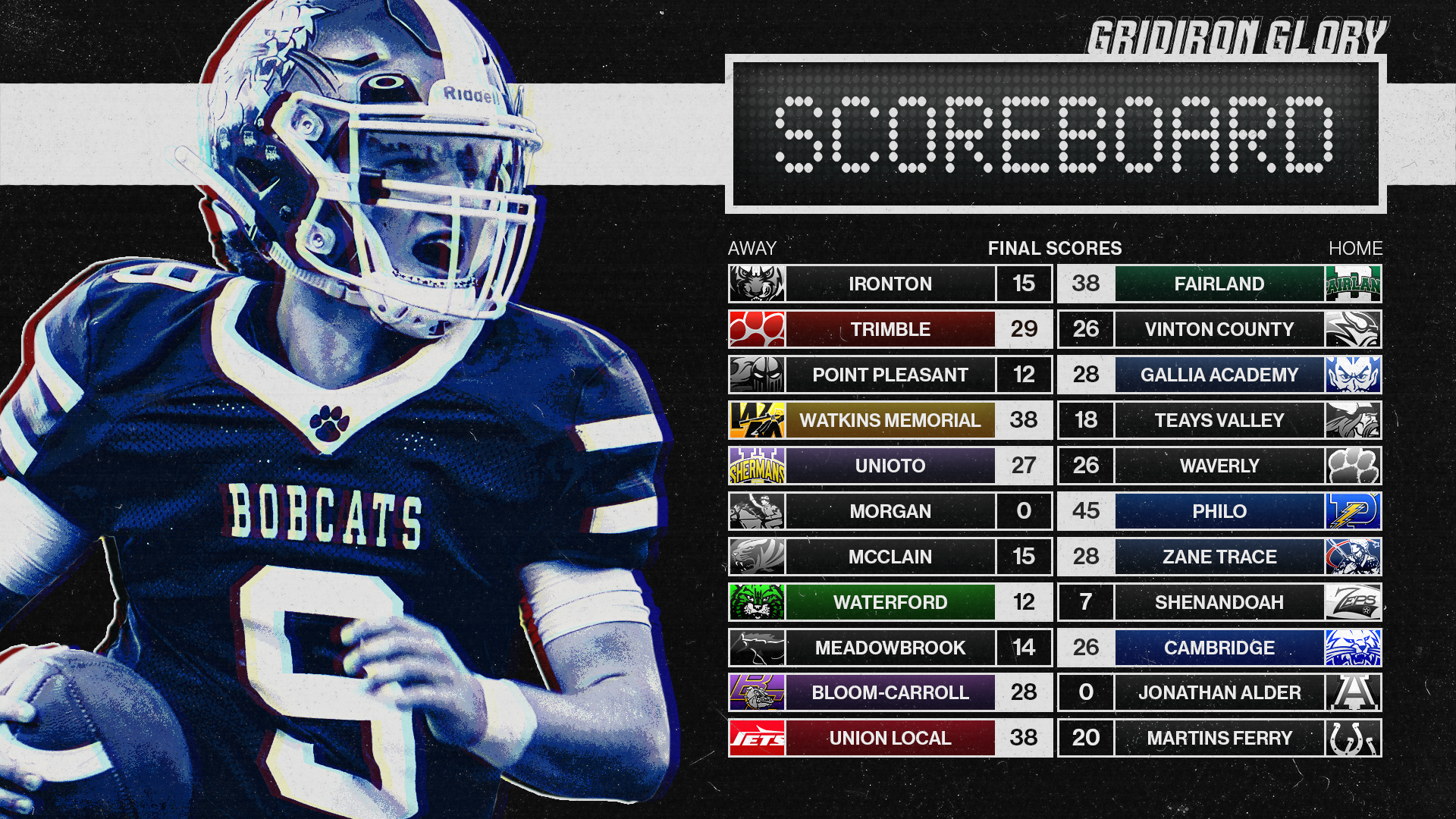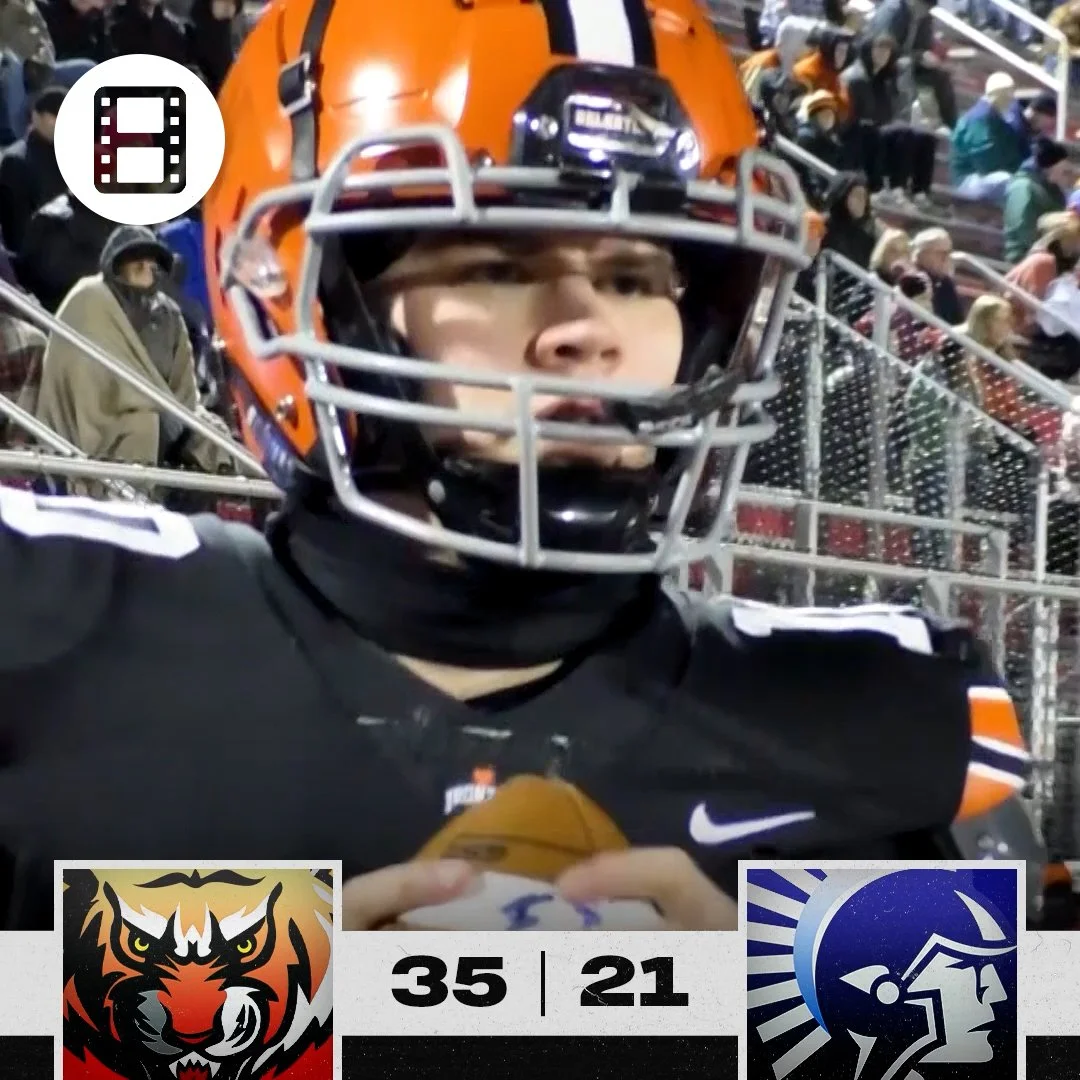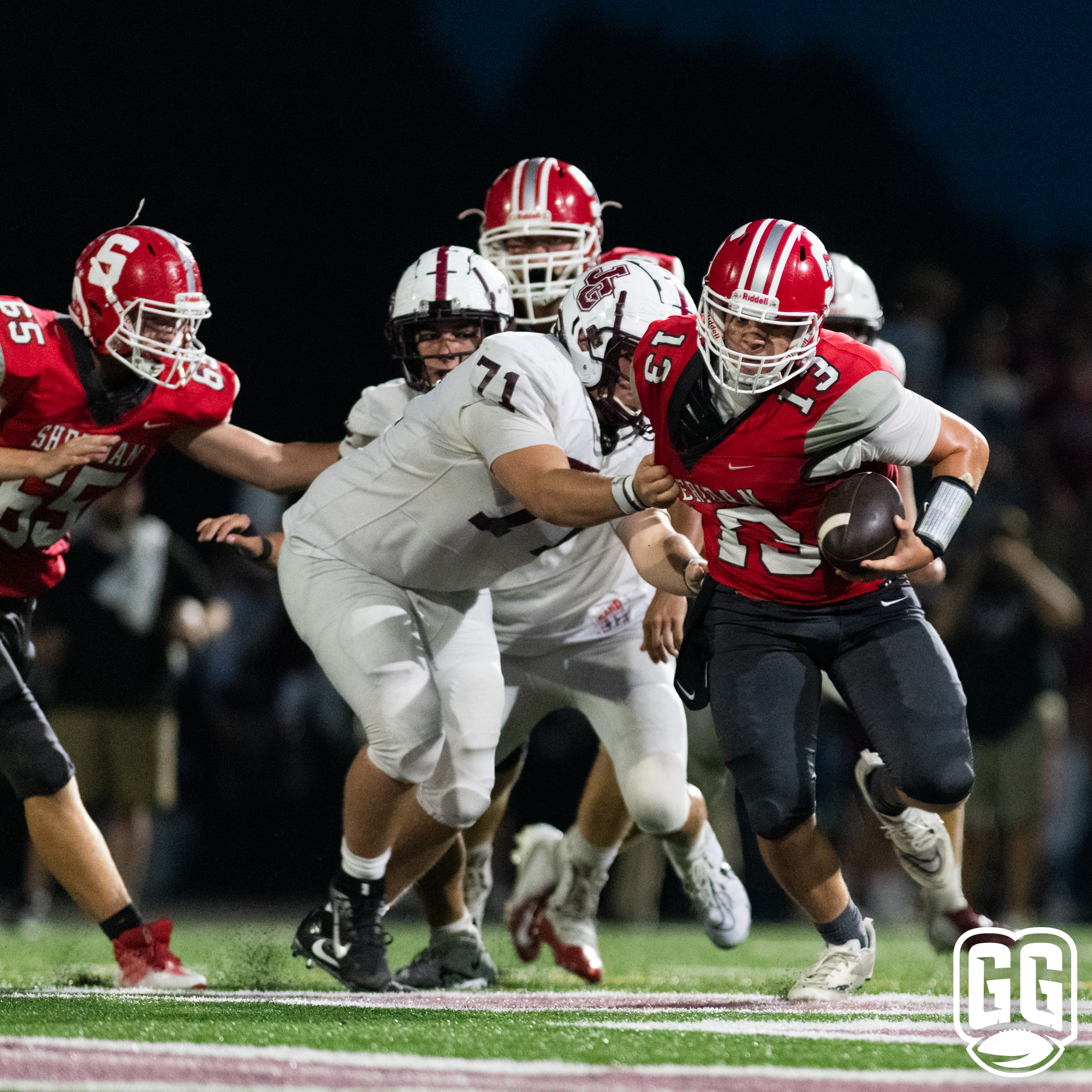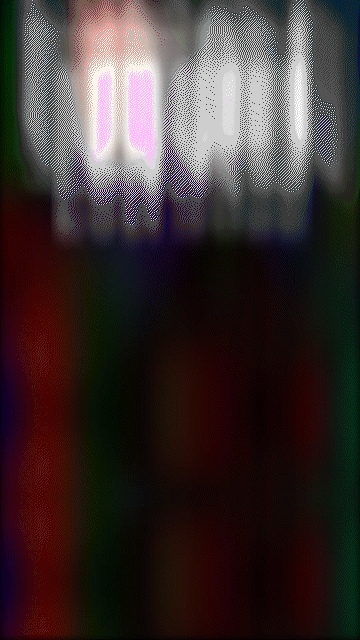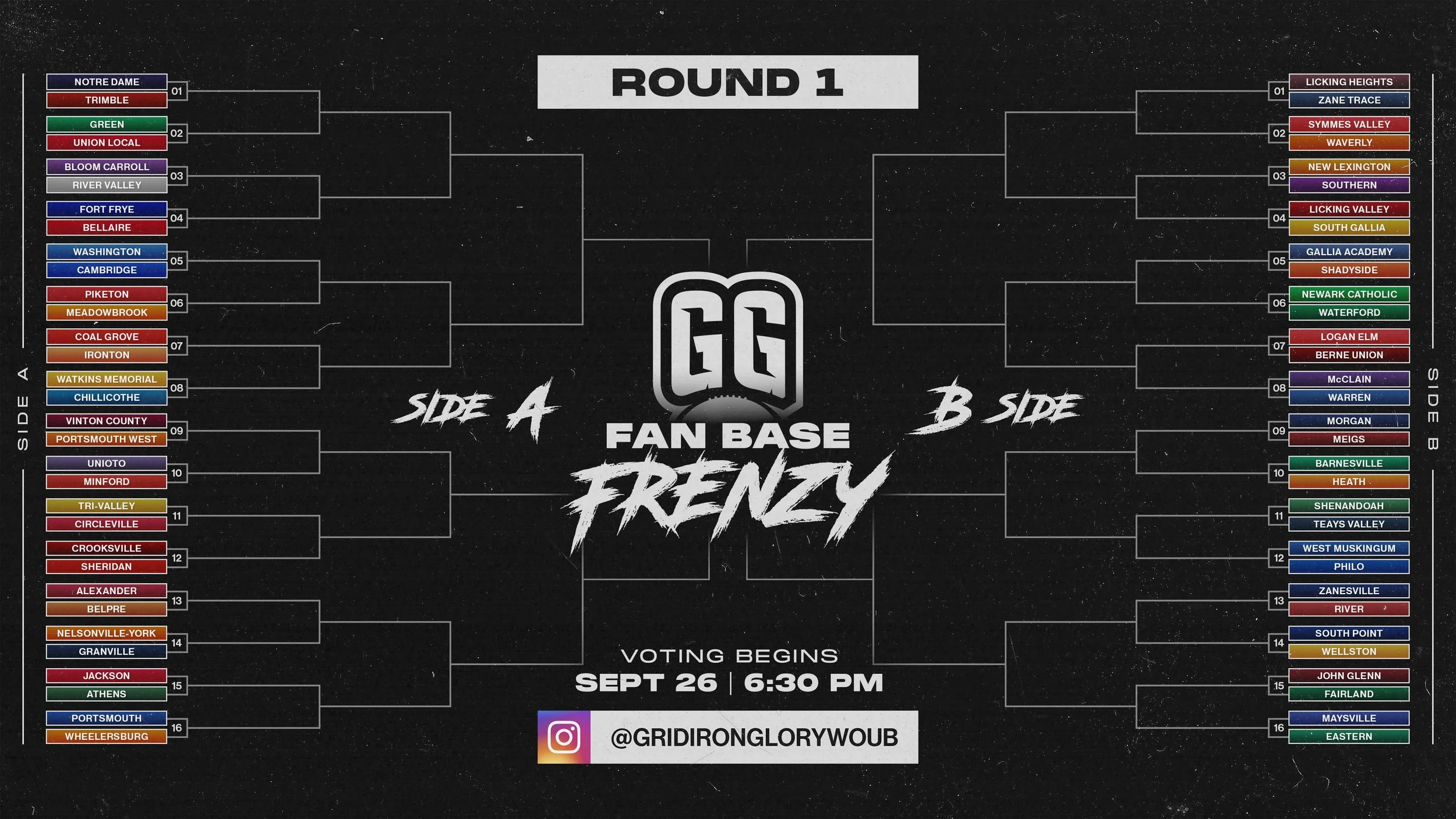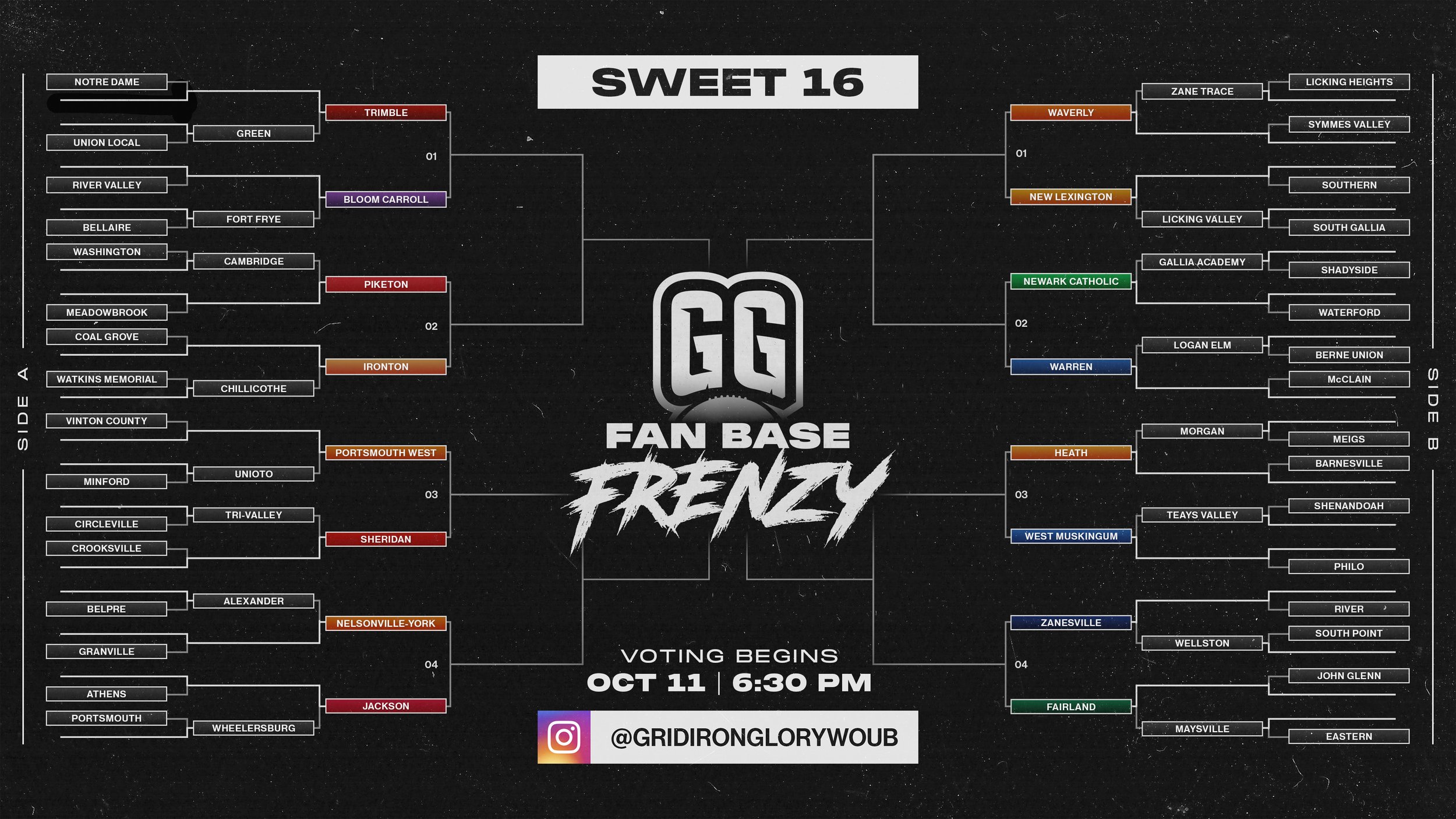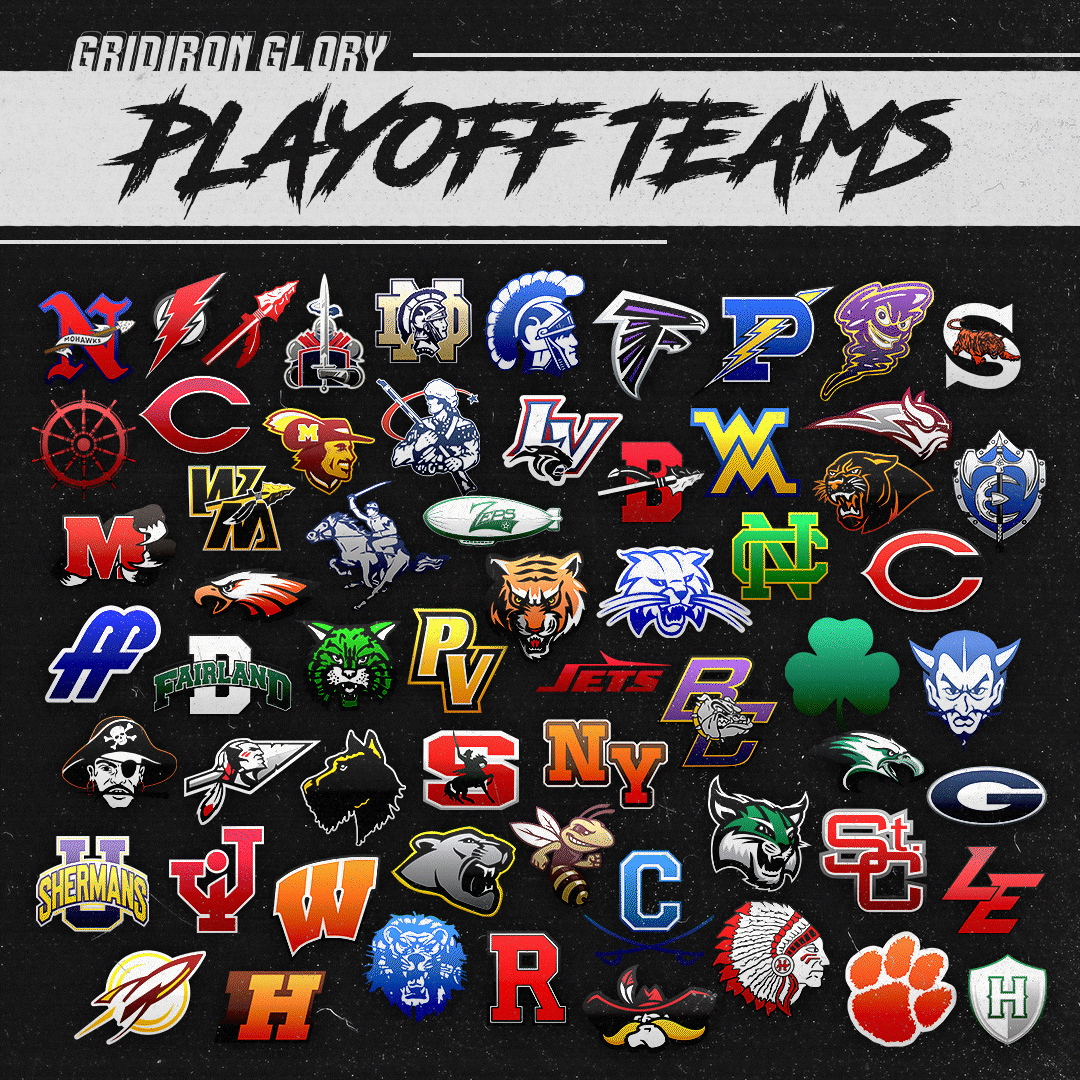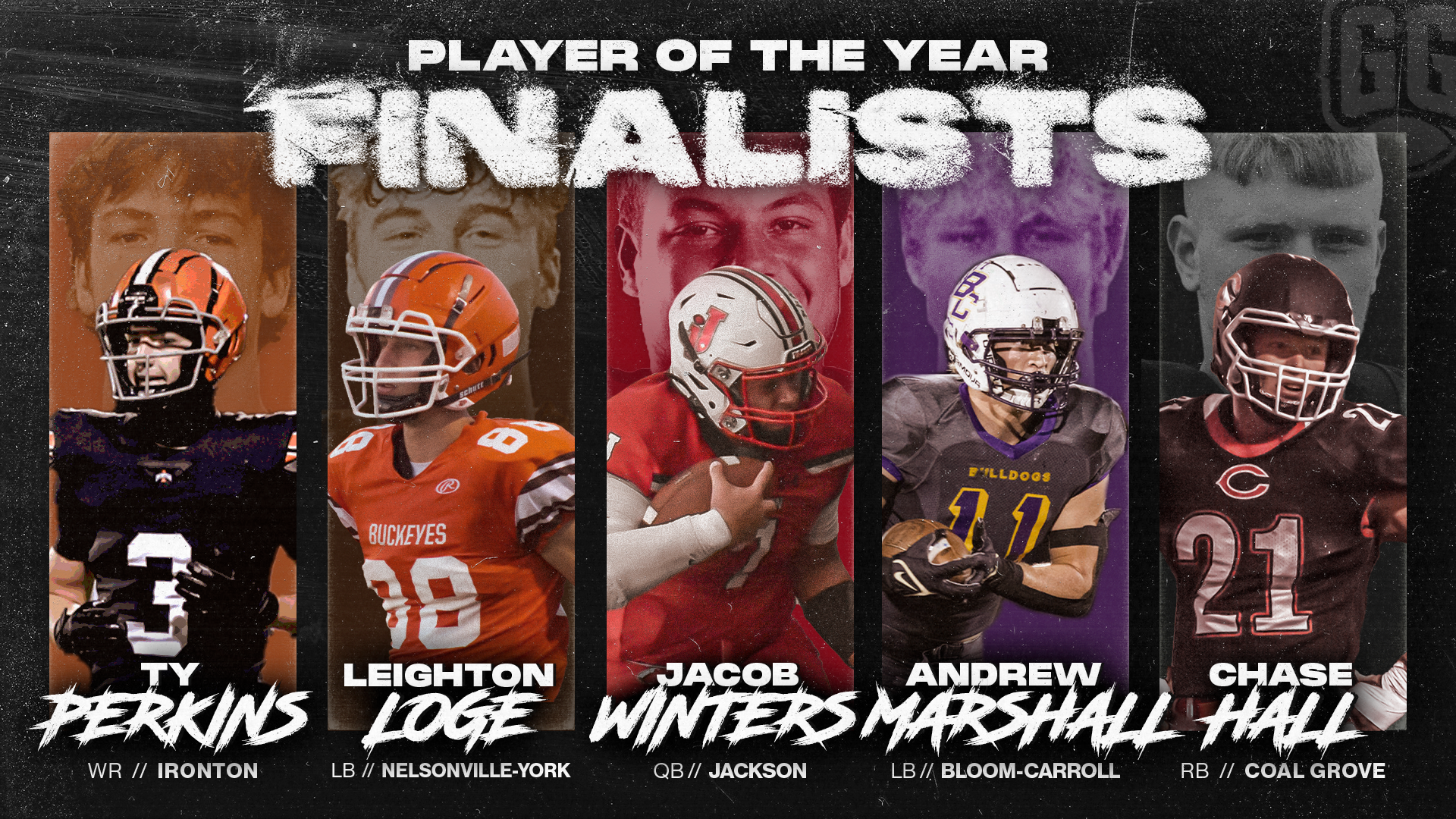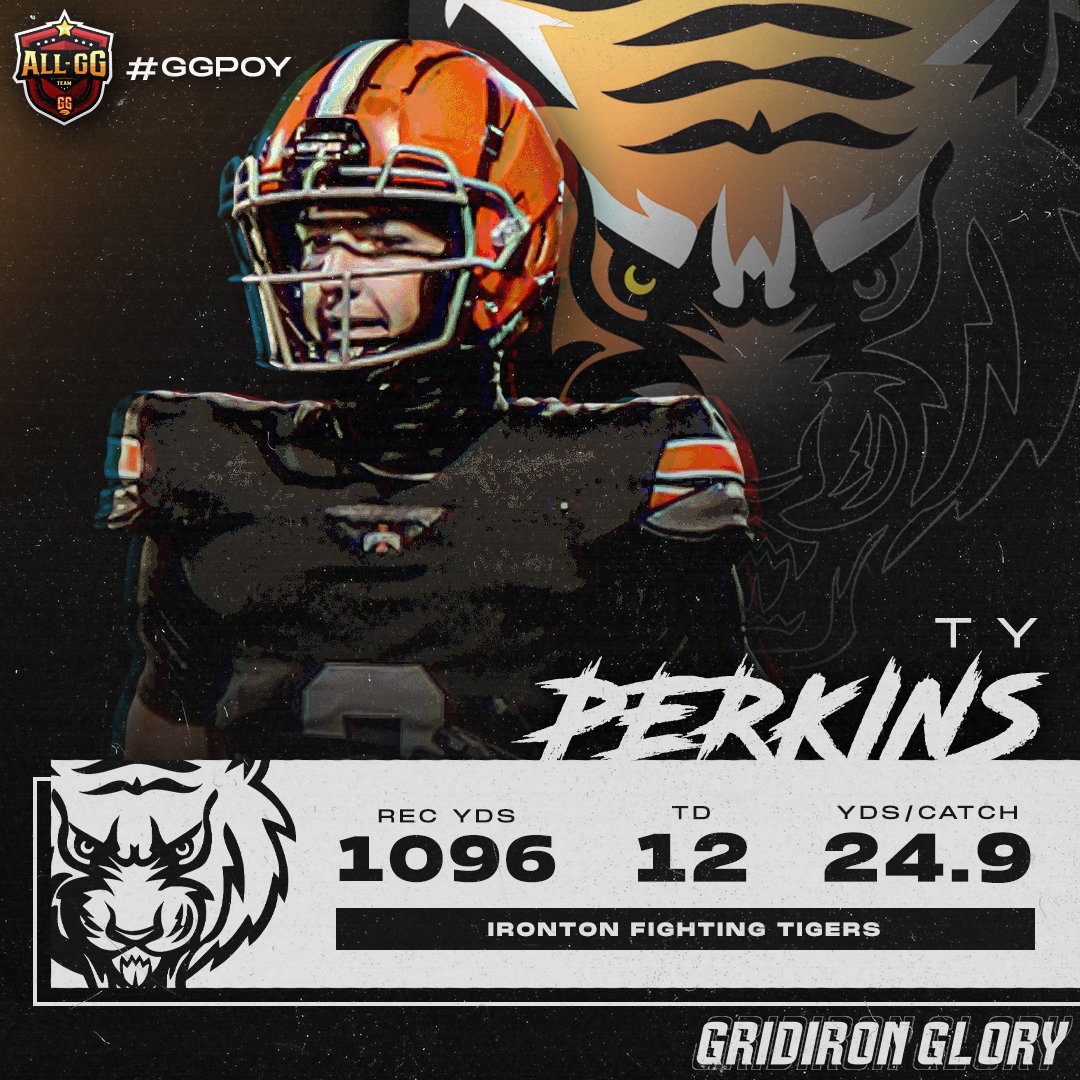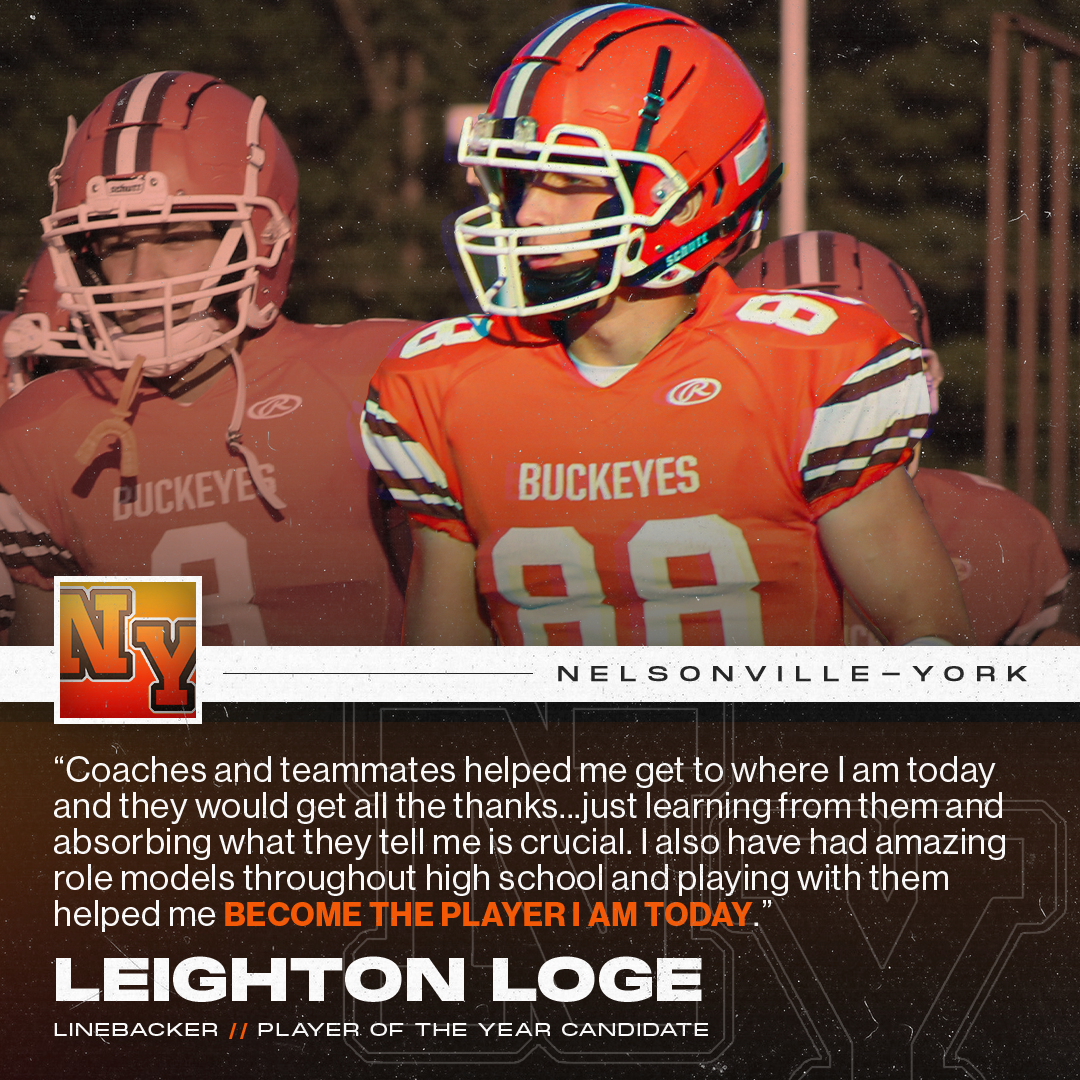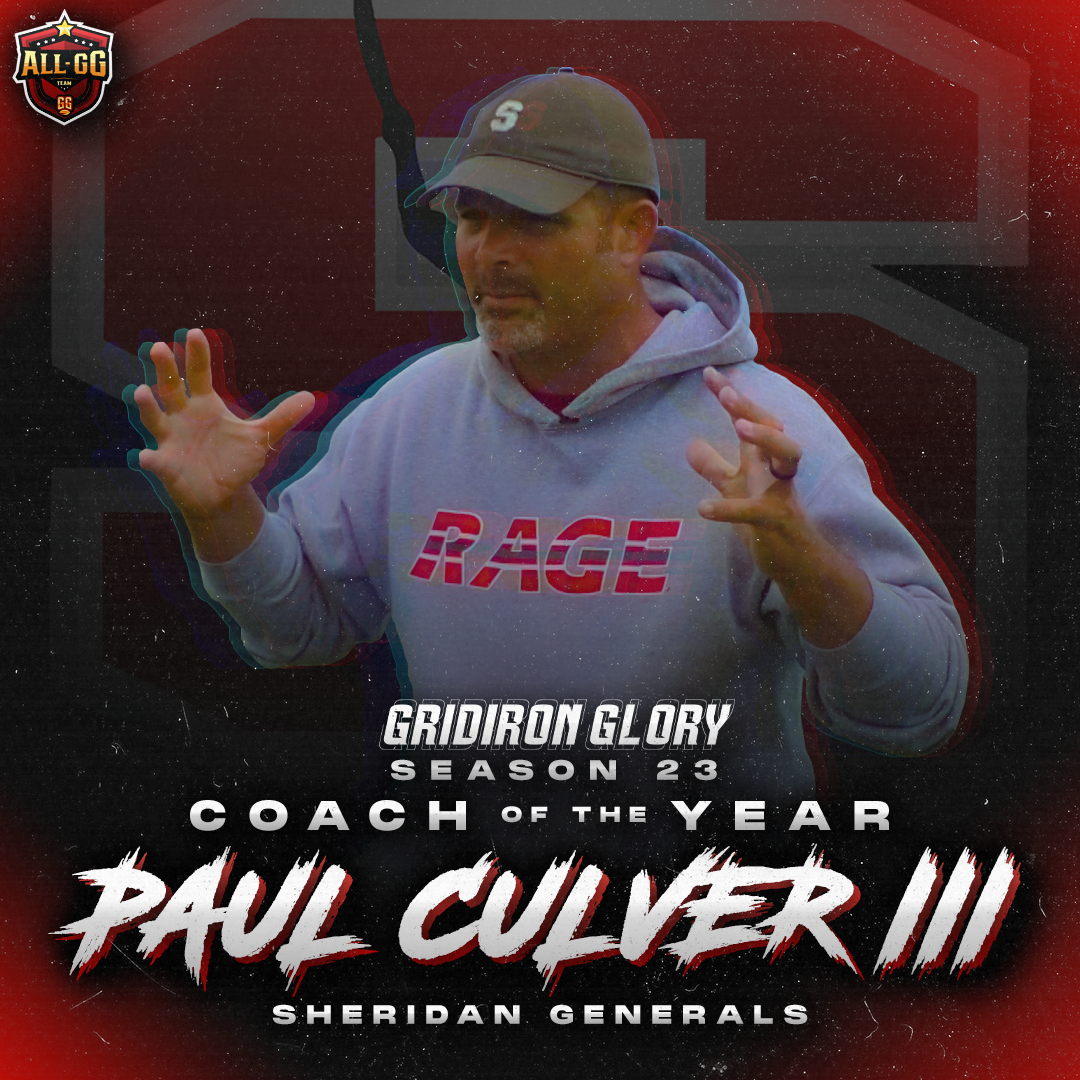OVERVIEW
JULY – DECEMBER 2022 // Gridiron Glory is an award-winning high school football news production at WOUB Public Media — the leading provider of sports media in southeast Ohio. As the producer of season 23, I not only cultivated the creative vision of our 30-minute Friday night newscast, but also oversaw the comprehensive content plan for all of our social/digital platforms. While I was not responsible for caption writing, weekly content schedules, or this season’s strategy, I coordinated all of our coverage and campaigns across all media. And as the art director and graphic designer, I created dozens of templates for our social media team to utilize throughout the season All the while, I coached and collaborated with our student reporters, videographers, designers, and technical crew as head of the executive staff.
GRIDIRON GLORY RETURNS
In keeping with last year’s precedent, on the 1st of July, we posted the season 23 teaser trailer to all of our digital platforms. The trailer served to kick off our daily pre-season coverage and was once again one of our highest-engaged posts on all platforms throughout the entire year.
The trailer also introduced the season 23 host, a role that changes each year with the senior class. A promotional graphic posted the next day introduced his senior reporters, who serve as co-hosts of the Friday night shows.
TEAM PREVIEWS & FEATURE STORIES
For the seven weeks between our digital launch and the first games, I assigned each of our 9 reporting teams (divided up by conference) to find feature stories, standout coaches/players, or interesting angles to the upcoming season on three of their teams for a total of 27 stories.
Packages were published regularly throughout the pre-season, and spread evenly to ensure daily coverage. Each story received a two-minute video piece posted on Facebook, Twitter, and YouTube. Articles were written by the reporters to accompany the videos on our website. Certain quotes were pulled and used for videos on Instagram and TikTok, or quote graphics on other social media platforms.
On all preview content, we tagged the teams and relevant players so that we could build outreach with the rising stars, and prime the communities in our coverage for more content down the line.
2021 REFRESHER
We made it a point to spread out last year’s conference results throughout the summer. We strategically posted the standings the day after previews of teams from that conference — to remind fans of who finished on top last year, and add further context to that team’s narrative this season. This also set the expectation for which teams we cover for audiences new to Gridiron Glory.
Game of the Week announcement graphic.
THE BUILDUP
When the regular season begins, Gridiron Glory sends out its team of reporters every Friday night to cover a handful of games across the region. This coverage is at the core of all GG content — and we put a great deal of effort into building interest in the days leading up to these games.
GAME OF THE WEEK
Our exec staff designated one matchup as “Game of the Week” based on community impact, playoff/conference implications, or other compelling storylines. Fans could expect additional digital coverage during and after the game — as well as a feature story spotlighting tradition, rivalry, or the “it” factor of that game. Toward the beginning of each week, we announced our game with this flashy graphic on all platforms.
FAN VOTE
24 hours before kickoff, we would post the GG Fan Vote to our Instagram stories. The posts encouraged fans to vote on who they believed would win each game Gridiron Glory was covering that week. Nearly half of our Instagram followers, and over 80% of story viewers, voted on each poll. It was also our first tease at which games we’d be featuring that week — and it proved effective at spreading the word
The results were used by reporters to ultimately tell a complete story that tied fan expectations in with the on-field performance. Each week’s fan vote was archived as a story highlight so that fans and reporters alike could look back on each week’s results.
GRIDIRON GLORY OVERTIME PODCAST
Our weekly podcast, hosted and produced by another student, was shared shortly after the Fan Vote. Gridiron Glory: Overtime kicked off each week’s slate of Digital Games (see below) with a ~5-minute conversation between the host and lead reporter for each game. Reporters provided insight into the key storylines, players to watch for, and predictions for each game. The podcast was promoted on social media alongside the list of games discussed and key soundbites.


GAMEDAY CONTENT
Fridays began with our list of featured matchups — most people’s first look at that week’s slate. We posted at around 10 a.m. Friday mornings, right before most high schools went to lunch, to generate excitement among students and players for the game. Had we posted any earlier, we risked our coverage being forgotten come Friday.
About an hour before kickoff, we shared the list of reporters providing live updates from each game on Twitter, linking their accounts in the caption. All reporters tagged @gridironglory and #BringGlory to promote the brand to all fans following along. As soon as each game went final, we posted the list of scores to all feeds. Square versions of each template were used on Instagram for formatting consistency.
This was our second year in a coverage expansion covering 9-12 games each week — and since then, we’ve covered each game under one of two classifications…
Game of the Week final score post.
SHOWTIME GAMES get in-depth coverage on that night’s episode of Gridiron Glory. These matchups are closest to the station, could host a live-shot, or could comfortably be left in time for our 11:30 broadcast. As for digital content, reporters who went on the air were responsible for tweeting videos of their segments. This helped our reporters build their social media presence and drove viewership on YouTube — as a link to the archived show was included in each tweet. An article for each game was also posted on the website — with the full episode embedded atop these articles.
DIGITAL GAMES were exclusively covered on our social media platforms — starting with previews on the Overtime podcast. These games were further from the station and could not be covered in-depth in time for the 11:30 show. Throughout the next morning, each game received a two-minute package recapping the action, complete with post-game interviews and analysis. These recaps were also included with the articles on our website.
GAME OF THE WEEK gets all the content of both a showtime and a digital game — the longest show segment, a full video recap, and then some. We also began giving GOTW its own final score post to further drive home its importance. Additionally, we’d gather footage of the fans, teams, or families involved in the Game of the Week storyline to publish a video feature before the show, setting the stage for a special matchup.
POST-GAME COVERAGE
Note: If we had the numbers, I would’ve loved for most content to be produced in the newsroom during games, and shared as soon as games ended. But in the interest of providing students the experiences they wanted, and covering as many games as possible, we opted to send all available staff out to games on Fridays and post our digital coverage on Saturdays.
GAME RECAPS
For all digital games and the Game of the Week, a reporter was assigned to write, track, and produce a two-minute video recapping the key plays and trends from the game. Their voice-over is also supplemented by post-game interviews.
Another reporter from the same game would produce a 300-word written recap to accompany the video on our website. Writers worked on the car ride back to get their articles submitted, edited, and posted by midnight.
Most student volunteers could not edit video on the road, nor did they return until after midnight. That’s why we adopted a 3 p.m. Saturday deadline to instead post video content at peak engagement times.
HIGHLIGHT REELS
Games that we expected to be high-scoring or high-intensity were assigned highlight reels — one-minute videos comprised of the best footage. Although all of our video was shot at 16:9, I taught our staff to motion track video for square social media posts. We overlayed a scoreboard or player stats onto the video to tie GG branding into the post.
Because they could be produced on a faster turnaround, these videos were posted first thing Saturday morning and spread throughout the weekend.
PHOTO ALBUMS
Our talented team of student photographers was small but packed a punch. Anytime a photojournalist was available for a game, a small collection of their photos was posted to social media. We selected games for photographers on a need basis — so that we had high-quality photos of every team by the end of the season.
While highlights are the buzz around a fanbase after a game, photos are far more timeless, so we reserved these posts for Sunday-Tuesday following the game.
After pushing out all of the content we gathered on Friday night — and before building up to the next slate of games — we had about three days to fill with other content. Aside from the three major campaigns outlined in the next sections, these were the main sources:
FEATURE STORIES
Southeast Ohio football — and small-town football everywhere — takes great pride in its community and traditions. Often times, this game is the glue that holds a family or a community together. That’s what I asked our reporters to seek out in feature stories. These stories often illustrated personal triumph in the face of great adversity. They’d premiere on the Friday night broadcast (sometimes in a condensed format), then get teased on socials to promote the show, before ultimately being posted online in full.
WEEKLY AP RANKINGS
After week three, and every week thereafter, local reporters with the Associated Press vote to rank the top teams in each division state-wide. These rankings don’t have as much implication as they do in college sports; however, as one of the only outlets covering southeast Ohio sports, it’s important that we keep fans up to date on which teams are ranked while filtering out the noise from the rest of the state.
These graphics were posted every Tuesday as soon as the rankings were published — and only included teams relevant to our coverage. The trend icons provided further context for fans who haven’t been following closely with every post.
CONFERENCE STANDINGS
Once conference play was well underway, for the back half of the regular season, we posted standings updates anytime there was a conference lead change. Because we cover nine of them, it would be overwhelming to post them all after every week (we did post them all at the end of the season).
I’d asked our team to implement an up-to-date standings module on our web homepage, but it just wasn’t in the cards this season. However, in addition to building up implications of key games on our show, this content structure was a fair solution.
When I ran our social media during last year’s Student Section Showdown, we saw massive success, singlehandedly resulting in a 46.3% following growth in just one month. That can be attributed largely to the new audiences from our coverage expansion — so although we were now into year two of the expansion, I wanted to take another shot in hopes of similar success. Of course, we couldn’t repeat the same campaign beat-for-beat, so we made a couple of tweaks:
Story post at the beginning of each Fan Base Frenzy round, designed by Will DeBlock.
1. TARGET AUDIENCE: This year’s content goals reached far beyond the games and students — and into the community traditions, atmosphere, and culture of football. With stories and coverage targeted at families and long-time residents, I felt our competition should focus on the same. It’s not just about the best student turnout, but the communities where football runs deep. So we broadened our competition to the “Fan Base Frenzy”
2. THE BRACKET: We kept the 64-team bracket format intact to reach as many communities as possible. But, with different teams emerging in our coverage, we only included teams we had seen up to that point, regardless of past year’s coverage. That brought in many new faces while leaving out teams who lost in the first round last year. We also shuffled the bracket to put schools up against their rivals in all rounds of the tournament.
3. THE PLATFORM: Last year’s voting took place on our main platform, Twitter, since all schools could be tagged and polls easily shared. Though cross-promoting the campaign created substantial growth on other platforms, we wanted to foster further growth on our newest platform, Instagram. Our Instagram following also has the most diverse age/demographic across all our platforms, which made it well-suited for the entire Fan Base.
4. THEME & ART DIRECTION: Because Instagram is much more visual than Twitter, and we needed to distinguish this year’s campaign, I met with our graphic designers to decide on a visual “theme” for the tournament. One was insistent on using our grainy art style to create vinyl records for each round, complete with tracklists that represent each matchup and album artwork for each school. This was the basis for all of our story posts.
The campaign began in Week 7 of the regular season, and voting for each round took place throughout the next five weeks. We integrated promotions into other platforms and the broadcast with both videos and graphic content. The final four teams were completely different than last season’s, which spoke to the success of our slight tweaks
CLINCHING SCENARIOS
One new resource we took full advantage of this season was Drew Pasteur’s Fantastic 50. The site provided live calculations on playoff chances and clinching scenarios for all Ohio teams. With three weeks left in the regular season, we took it upon ourselves to clean up that data, write out the scenarios in plain language, and compare them within the conference as teams geared up to spoil their rivals’ seasons.
The full article covered scenarios for 50 teams and gathered nearly 4,000 pageviews in just three days, making it one of Gridiron’s top three articles of the season. This social media graphic served as an overview of the entire region and drove audiences to the website to read up on their teams.
WEEKLY PLAYOFF PICTURE
After outlining all the clinching scenarios in week 8, weeks 9 & 10 brought detailed graphics that laid out the playoff picture for each division/region. The biggest challenge was fitting more than a dozen teams (and a photo) on each slide. We opted to omit teams not in our coverage/relevant to our audience and clarify with text that only 16 teams qualified in each region.
One design decision I would change — instead of dividing teams by clinched/in the hunt, separate the top 16 from those on the outside. I could’ve kept the percentages to depict which teams hadn’t yet clinched, and used x/y/z notations to denote clinched berths, top 8 seeds, and top 4 seeds. Trend icons would indicate which teams had newly clinched, or were now outside the bubble.
REGIONAL TOURNAMENT BRACKETS
The final night of the regular season was all hands on deck as reporters compared seeding scenarios to game results to project the final tournament brackets. On that night’s broadcast, we were among the first to “break the news” with our tentative brackets, which ultimately matched the OHSAA with 100% accuracy.
When the official brackets were published the next day, our social media graphics were already made. And every Saturday thereafter, we updated the brackets by greying out the losing teams and illustrating next week’s matchups between winners.
REMAINING TEAMS
Before every round, we’d post a collage of the logos for all teams still battling in the playoffs. A simple call-to-action to “double-tap,” “retweet,” or “comment” for fans who saw their team made these our most engaged posts. Once the regional playoffs were done, we created a sort of time-lapse showing how the remaining teams morphed each week.
Gridiron Glory spends the final weeks of each season building up to the hour-long finale — a reflection on the triumphs and storylines of the season, including those of five Player of the Year finalists. But we wanted to make the finale and its buildup about more than just the fan-voted POTY. That’s why we created the All-GG Honors with the 2021 expansion — and improved on its success for Season 23.
PLAYER OF THE YEAR
Because of its longevity and prestige, the Player of the Year campaign is a year-long discussion. Reporters noted stand-out players as potential nods every week — but the list needed to maintain exclusivity, and to demand season-long success. So, after teasing the watchlist all year long, we finally announced that we’d be revealing our first edition later that night on the Week 9 broadcast. The episode had more live viewers than any other.
From the 12 initial players, we promised to narrow down the list week-by-week until voting opened for five finalists. Two weeks later, we teased and announced the 8-player list, before finally revealing the finalists and opening voting the next week.
Player of the Year teaser for the first watchlist.
The first Player of the Year watchlist, revealed after Week 9.
Player of the Year finalists. Designed by Will DeBlock, WOUB.
By now, fans were accustomed to knowing it was their time to vote for one of the five finalists. Yet we continued to promote it for the entire 10-day voting period — spotlighting each player’s stats, giving them each a quote graphic to make their case, and plugging the voting link wherever possible. The article detailing each of their seasons was our second most-read article of the season. We amassed 6,490 votes on our website — 33% more than the previous season and the most in GG history.
Design by Conor Mallonn, WOUB
Design by Conor Mallonn, WOUB
Design by Conor Mallonn, WOUB
COACH OF THE YEAR
In recent years, the staff has also selected a Coach of the Year for their successes on the field and in the community. This award is not open to the fans for voting and plays second fiddle to the GGPOY — but it’s still important to show audiences who we’re considering and feel deserves an honorable mention. Fans proved that by making the reveal among our top five engaged tweets of the season.
Because this isn’t a fan engagement campaign, we went quiet on Coach of the Year after its week 10 reveal, until revisiting each coach’s end-of-year resume on the Week 13 broadcast — just one week before the finale.
Coach of the Year teaser, shared the morning of our Week 10 broadcast.
Coach of the Year candidates, shared after the reveal on the broadcast.
ALL-GG TEAM / SEASON FINALE
With Player of the Year voting closed, and coaches primed for the award, all branding and promotion shifted to the upcoming season finale. We announced that we were renewing the All-GG Team, which would honor 50 players from all parts of southeast Ohio and all positions on the field to create an All-Star roster. Throughout the season finale, fans could expect “first-team” recognition of 11 offensive & 11 defensive players, stats & accolades for all 50 players — and of course, the reveal of the Coach and Player of the Year.
Building the roster was a month-long process that began as soon as the regular season ended. Our lead reporters all came prepared with their own pitches for players that stood out to them. I also had them seek the opinions of coaches, whose insights were perhaps even more valuable than our own. All of that information was compiled in a comprehensive stats spreadsheet with more than 100 players. It took weeks of meetings with leads and all-staff — in the heat of playoff coverage — to narrow the list to 50.
In forming our final roster, we wanted to ensure that a variety of teams and conferences were represented, and that we didn’t overpopulate the roster with the biggest/most competitive schools. I capped off the number of players from specific schools based on that team’s season success, and likewise, created a minimum for our most successful teams.
All-GG full roster. 22 players above the line received first-team recognition.
All-GG offensive lineup. 11 “starters” have their trading cards pictured.
All-GG defensive lineup. 11 “starters” have their trading cards pictured.
Thanks to the support of our reporters and photographers, we had a backlog of stats, highlights, and photos of all 50 players compiled by our digital team. Using those resources, all 50 players were not only recognized on the finale, but each had digital trading cards designed for them. These cards made up our offense & defense lineups, and were shared individually on social media in the days following the season finale.
This helped keep engagement up in the days leading up to state finals, as every one of the fifty players and their families had a reason to share our content. For the second year in a row, this was our highest-performing series of posts, particularly on Instagram. The announcement of Coach of the Year and Player of the Year also received substantial attention on social media when they were posted immediately upon their announcement on the show.
Design by Conor Mallonn, WOUB
Design by Conor Mallonn, WOUB
Design by Conor Mallonn, WOUB






